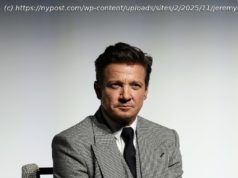“Incredibles 2” director Brad Bird says his Disney animator mentor taught him it’s “possible to achieve success if you’re willing to put in the time.”
Brad Bird is one of the biggest names in animation today as the writer and director of “Incredibles 2” by Walt Disney’s Pixar, which hit theaters on Friday. The sequel to Oscar-winner “The Incredibles” (2004, also with Bird at the helm) was 14 years in the making and has already set records for advanced ticket sales, putting the movie on track to pull in as much as $140 million in its first weekend at the North American box office. Bird has also had other blockbuster hits, like Pixar’s 2007 “Ratatouille.”
But it was a gutsy risk Bird took as a 14-year-old that set him on a path to unimaginable success.
He’s now 60 and a famous and award-winning writer-director-producer. But Bird was once just a kid growing up in Oregon who dreamed of a career as a Disney animator.
“Like most kids, I loved cartoons and watched them constantly on television. I loved their broadness and imagination, that they felt so vital,” Bird told “The Simpsons” actress Nancy Cartwright in an interview in 2009.
Bird specifically loved Walt Disney movies, which he called “spellbinding,” and which inspired him to start drawing cartoons at a young age.
When he was 11, Bird started working on his first animated short film — an adaptation of the classic tale “The Tortoise and the Hare.” At the time, a family friend who had attended college with Disney composer George Bruns (“Robin Hood,” “The Sword in the Stone”) arranged for Bruns to give young Bird a tour of the Disney studios in Burbank, California. During the tour, Bruns told some of the Disney animators about Bird’s own animation project. The seasoned animators gave him “this patient smile,” Bird said in 2009.
“Those guys were shocked when I sent them a completed 15-minute film three years later,” Bird said. Indeed, the then 14-year-old Bird mailed his unsolicited finished animated short to the animators at Walt Disney. And the movie was good enough to catch the attention of some important people at the iconic animation studio.
Bird told Cartwright in 2009 that he made the short movie in his parents’ basement with an 8mm camera in a workroom his father built for him. “He’d bought a used 8mm camera that was capable of shooting one frame at a time for me, and he jury-rigged it into a camera enlarger stand pointing down at a place where I’d slide my drawings into position to photograph,” Bird said.
Disney’s reaction to Bird’s early attempt at animation was extremely supportive. “They basically said ‘Any time you’re in L.A., the door’s open and you can work with our guys,'” he told Fast Company in 2015 . “I’d go down there for a week or two at a time staying with family friends who’d drop me off every morning at the Disney studio. They set up a little room for me and I was given assignments by these people. It was staggering for me.”
Disney assigned a mentor to Bird, allowing him to work with legendary animator Milt Kahl, who had worked on the studio’s earliest iconic films, such as “Snow White and the Seven Dwarfs” and “Bambi.”
“Milt was incredibly exacting and he didn’t like laziness,” Bird told Fast Company. “‘Don’t just go with the first thing that comes to your mind.’ Milt impressed on me at an early age that it was possible to achieve success if you’re willing to put in the time and explore many avenues. But it wouldn’t happen by just doing things half-a–ed.”
Meanwhile, back in Oregon, Bird’s ambitions toward an animation career weren’t exactly being supported by his junior high school guidance counselor, who tried to convince the young Bird to pick a more traditional career path than filmmaking. “He’d say, ‘If movies didn’t exist, what would you do?’ And I’d say, ‘I’d have to invent them,'” Bird told The Los Angeles Times in 2008.
Eventually, Disney even gave Bird a scholarship so he could attend the California Institute of the Arts — a school with a reputation for churning out skilled animators — where he met future colleagues such as John Lasseter, who became chief creative officer of both Pixar and Walt Disney Feature Animation in 2006. (A recent sexual harassment scandal forced the company to part ways with Lasseter .)
Bird took a job with Disney as an animator after graduating from college. He worked on the 1981 animated film “The Fox and the Hound” and 1985’s “The Dark Cauldron” but he was fired by the studio after only a couple of years for “rocking the boat,” he claims. Bird told New York Magazine’s Vulture in June that he clashed with a group of Disney animators and executives who, he said, “tended to play everything so safe, which is a bore.”
Instead, Bird spent over a decade working mostly on animated television shows such as “The Simpson,” “Rugrats” and “King of the Hill.” Bird’s big breakout finally came in 1999, when he wrote and directed the Warner Bros. animated movie “The Iron Giant,” which did not perform well at the box office, but it was still a hit with critics and, years later, is viewed as a cult classic .
The following year, Bird joined Lasseter at Pixar and started working on “The Incredibles,” which Pixar released in 2004 with its distribution partner, Walt Disney Studios. Bird’s homecoming with Disney went into full effect in 2006, when the company bought Pixar for $7.4 billion .
Along with “Ratatouille” and “Incredibles 2,” Bird also served on Pixar’s senior creative team since 2009’s “Up.” And he wrote and directed the live-action Disney movie “Tomorrowland” ( a famous flop) in 2015, which was only his second live-action movie after directing 2011’s “Mission: Impossible – Ghost Protocol” for Paramount Pictures.






